Research and publications
Explore the data on PentaHibe Base and PentaHibe Complete tested on different cell types for viability, recovery and proliferation.
Deep dive into the publications and download our protocols for guidance.
Complete
A ready-to-use cryopreservation medium containing 10% pentaisomaltose and 2% DMSO, PentaHibe Complete can be used used across a range of cell types and for tissue cryopreservation in organoid generation.
T cells

Objectives: to compare and evaluate the viability and recovery of T cells purified from buffy coats after cryopreservation with a self-made 10% DMSO formulation, a commercial product with 10% DMSO, or ready-to-use PentaHibe Complete.
Results: T cells purified from buffy coats from healthy donors and cryopreserved with PentaHibe Complete show similar viability and recovery to those cryopreserved with self-made and commercial formulas containing 10% DMSO.
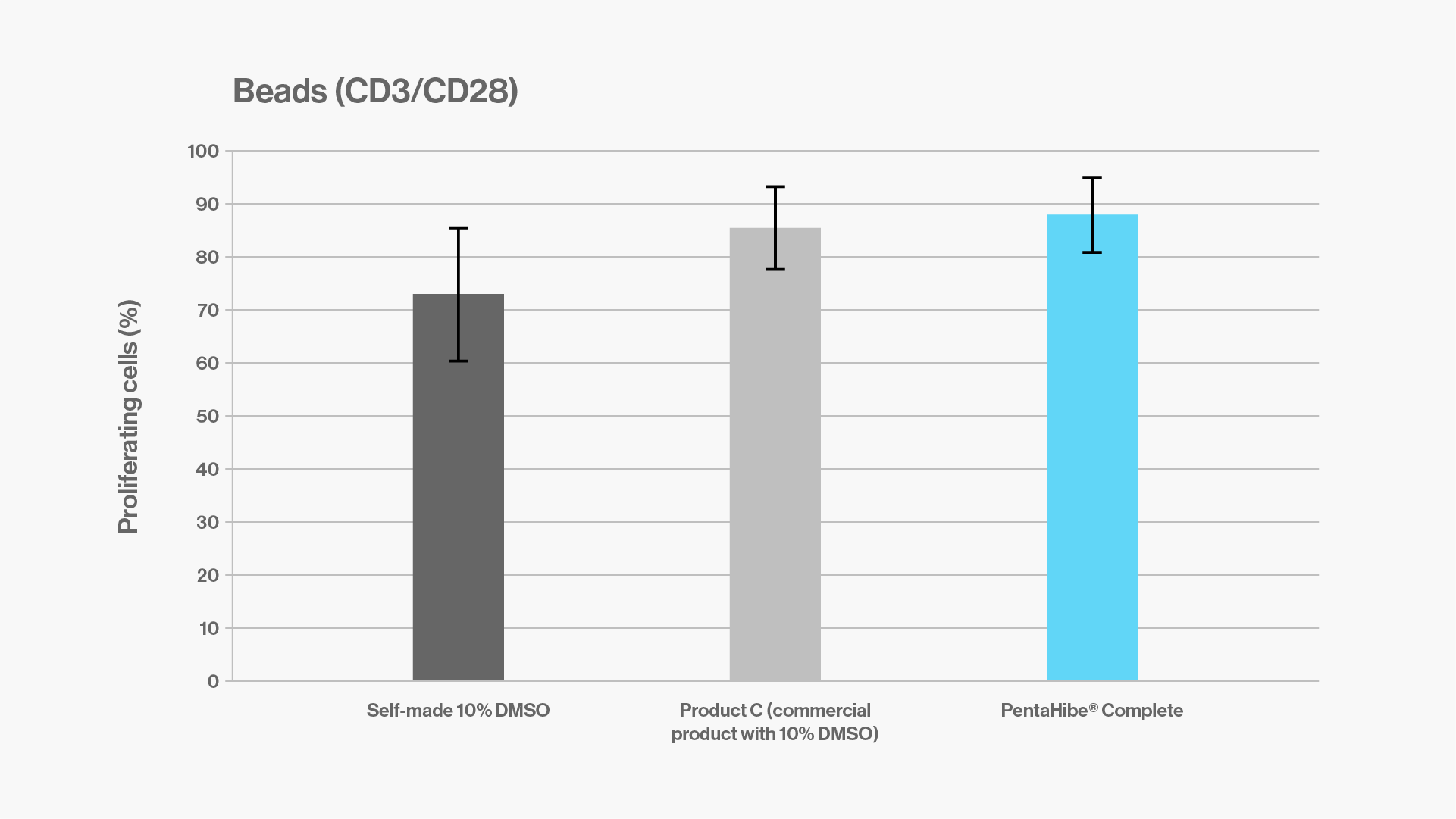
Objectives: to compare and evaluate the proliferation of T cells purified from buffy coats after cryopreservation with a self-made 10% DMSO formulation, a commercial product with 10% DMSO, and ready-to-use PentaHibe Complete.
Results: T cells purified from buffy coats and cryopreserved with PentaHibe Complete show similar proliferation as those cryopreserved with self-made and commercial formulas containing 10% DMSO.

Objectives: to evaluate the expansion capabilities of T cells post-cryopreservation using PentaHibe Complete compared to a commercial product containing 10% DMSO. T cells were stimulated with IL-2 and anti-CD3/CD28 antibody beads, and their expansion was monitored over a 15-day period. Expansions were calculated from the accumulated count of viable T cells on selected days after thawing.
Results: T cells purified from buffy coats of healthy donors and cryopreserved with PentaHibe Complete showed similar expansion comparable to those preserved in a commercial formulation containing 10% DMSO.

Objectives: To evaluate the post-thaw viability of T cells cryopreserved with PentaHibe Complete. Viability was measured at different time points (0, 6, and 24 hours post-thaw). The study aimed to assess the effectiveness of PentaHibe® Complete in maintaining high viability for downstream applications in cell therapy research.
Results: PentaHibe Complete demonstrated exceptional post-thaw viability, with >90% viability immediately after thawing. Over a 24-hour culture period, viability remained high (80-85%), providing an extended window for handling and processing. These findings confirm that PentaHibe Complete is an effective cryoprotectant for preserving the integrity and functionality of T cells in translational research.
Human mesenchymal stem cells

Objectives: to compare and evaluate the viability of adipose tissue derived human mesenchymal stem cells after cryopreservation with a self-made 10% DMSO formulation, a commercial product with 10% DMSO, or ready-to-use PentaHibe Complete.
Results: PentaHibe Complete is suitable for the cryopreservation of adipose tissue derived human mesenchymal stem cells.
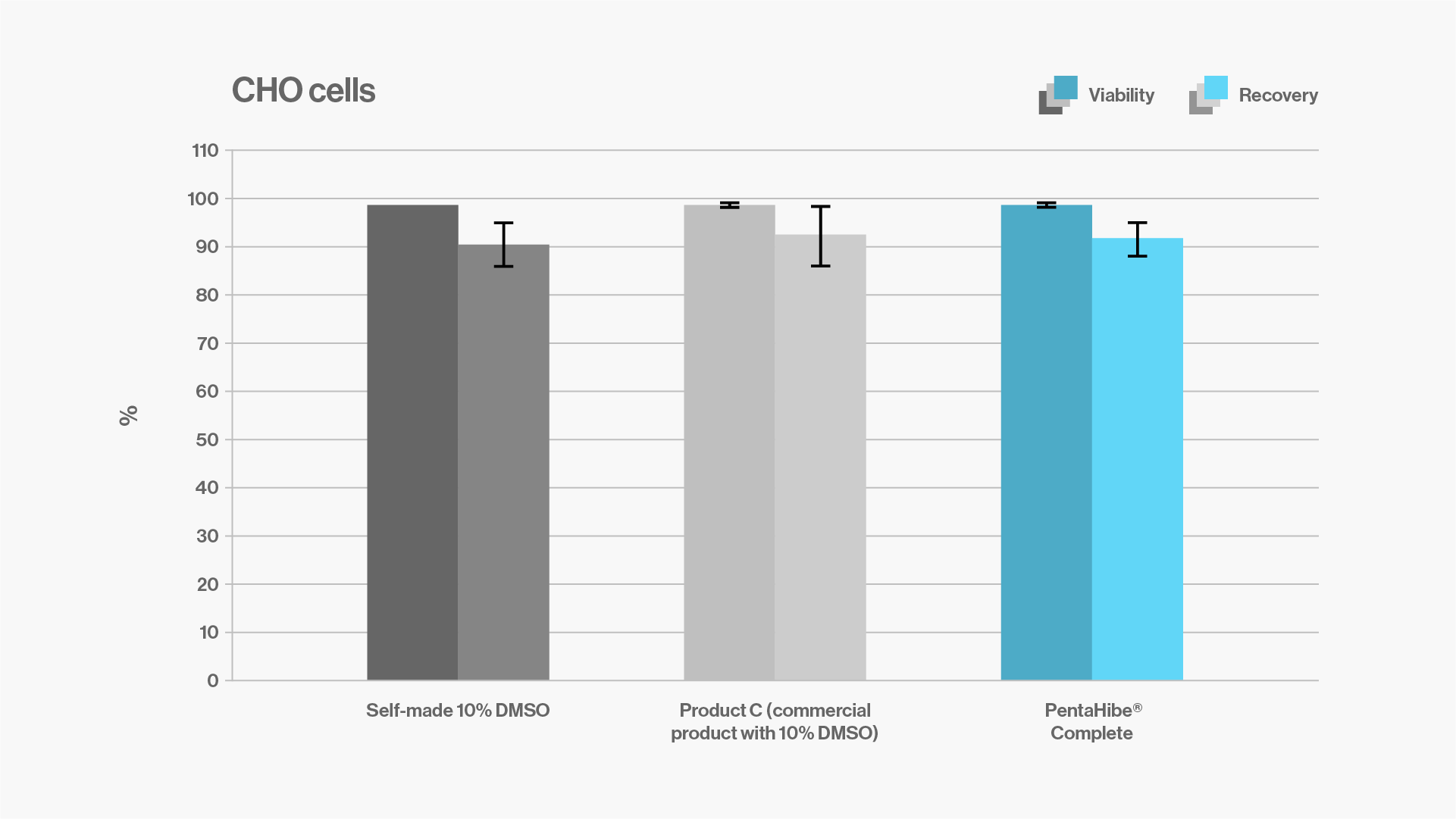
Objectives: to compare and evaluate the viability and recovery of CHO cells after cryopreservation with a self-made 10% DMSO formulation, a commercial product with 10% DMSO, or ready-to-use PentaHibe Complete.
Results: CHO cells cryopreserved with PentaHibe Complete show similar viability and recovery to those cryopreserved with self-made and commercial formulas containing 10% DMSO.

Objectives: to compare and evaluate the viability and recovery of HEK293 cells after cryopreservation with Pentahibe Complete or with a commercial product with 10% DMSO.
Results: HEK cells cryopreserved with PentaHibe Complete show similar viability and recovery to those cryopreserved with commercial formula containing 10% DMSO.
Data generated in the Zilbauer Group, Cambridge Stem Cell Institute

Objectives: to evaluate the ability to successfully establish organoid cultures from intestinal mucosal biopsies (duodenum, ileum, and colon) cryopreserved with either Pentahibe Complete or a conventional 10% DMSO-based medium.
Results: biopsies cryopreserved with Pentahibe Complete demonstrated a 100% organoid establishment success rate, compared to 64.29% for the standard freezing medium, across all intestinal segments.

Objectives: To assess the impact of Pentahibe Complete versus a conventional 10% DMSO-based freezing medium on both the number and area expansion of organoids derived from duodenum (Duo) biopsies over time, using time-lapse imaging analysis.
Results: Biopsies cryopreserved in Pentahibe Complete consistently produced a higher number of organoids and exhibited substantially greater area expansion compared to those frozen in a standard 10% DMSO-based medium over a 180-hour observation period. Time-lapse imaging confirmed these findings, revealing increased organoid count (Fig. 1a) and larger organoid area (Fig. 1b) over time, with representative images demonstrating robust growth by day 13 post-thaw (Fig. 1c). These results underscore Pentahibe Complete as an advanced solution for preserving tissue integrity and promoting efficient organoid generation.⁷
Base
A natural carbohydrate-based cryoprotective agent, PentaHibe Base is a safe and effective alternative to dimethyl sulfoxide (DMSO) for cryopreservation of cells.
The following data is an example of how to use PentaHibe Base as the sole CPA for cryopreservation of hematopoietic stem cells.

Objectives: to demonstrate that DMSO can be replaced with 16% PentaHibe Base as a safer cryoprotectant for the cryopreservation of peripheral blood stem cells.
Results: the recovery of viable CD34+ cells using PentaHibe Base is comparable to DMSO.
Note: The recovery of CD34+ cells from apheresis samples after thawing is expressed as the percentage of the number of CD34+ cells before cryopreservation. Each data point represents duplicate measurements for each donor.

Objectives: colony-forming cell (CFC) assays were set up to investigate whether HPCs in cryopreserved HPC(A) samples retained their hematopoietic potential and were able to produce cells of the myeloid and erythroid lineages.
Samples cryopreserved in either 10% DMSO or 16% PentaHibe Base contained viable HPCs with the potential to produce colonies of the CFU-E and BFU-E, CFU-G, CFU-M, CFU-GM, and CFU-GEMM lineages.
Results: HPC(A) samples cryopreserved in either PentaHibe Base or DMSO show comparable colony-forming potential.
In vivo study
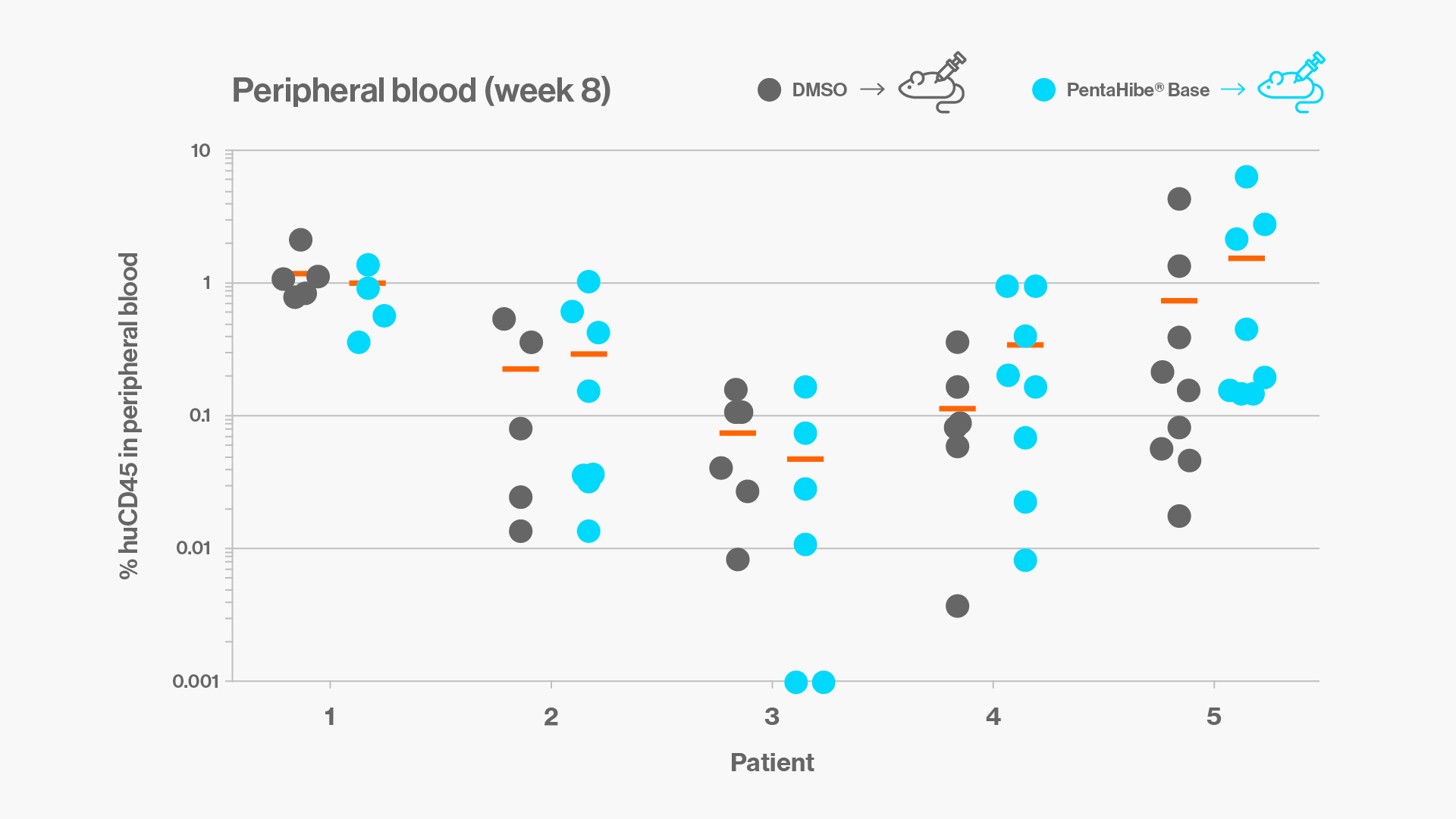
Objectives: to measure hematopoietic engraftment of human CD45+ cells in 8-week peripheral blood samples from immunodeficient laboratory mice.
Engraftment was evaluated by flow cytometry, which was calculated as the frequency of human CD45+ cells in peripheral blood at 8 weeks post transplantation.
Results: Engraftment levels were comparable when using either PentaHibe Base or 10% DMSO at 8 weeks. No significant differences in the frequencies of human CD45+ cells in the samples cryopreserved in PentaHibe Base or DMSO.
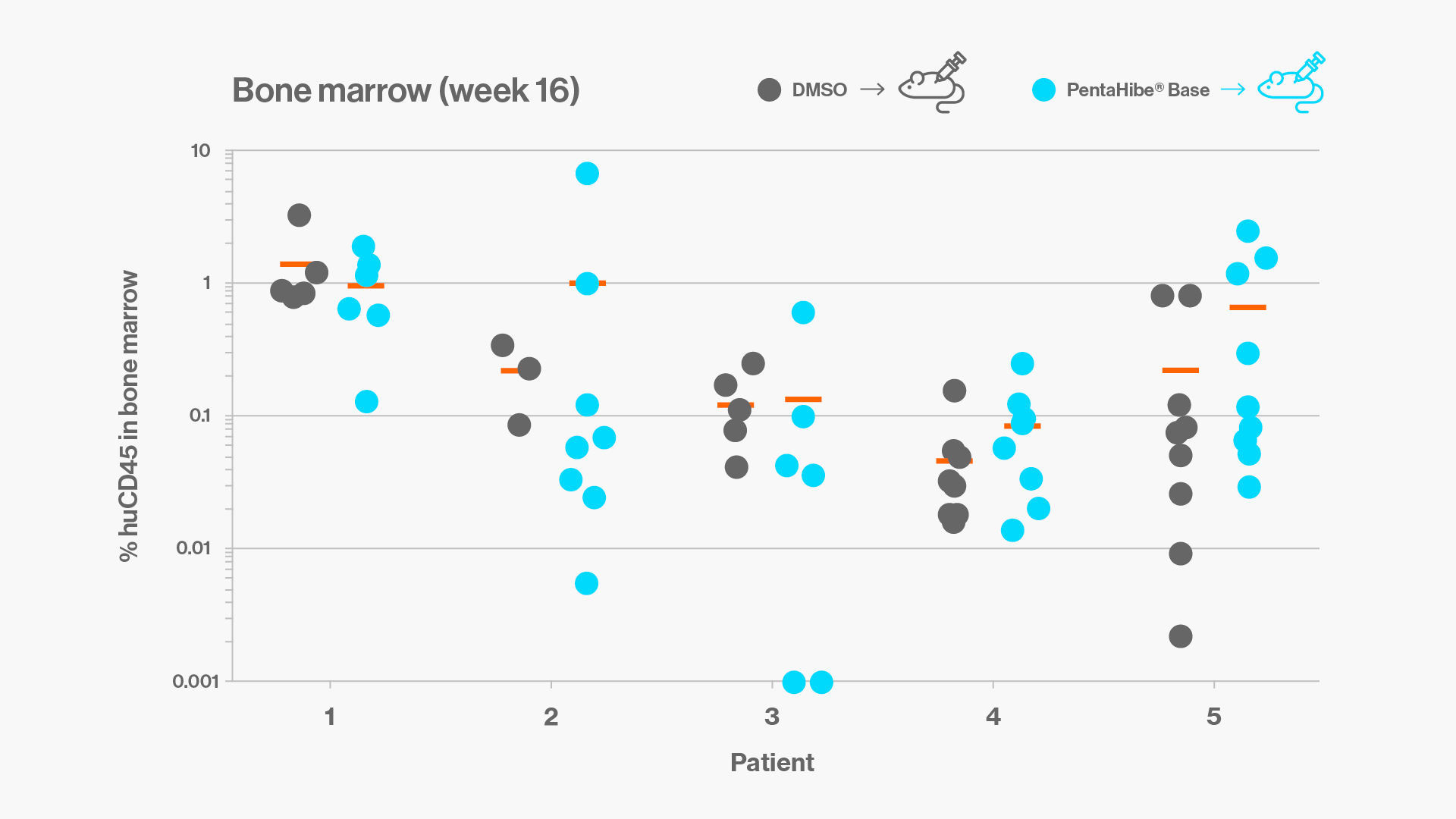
Objectives: to measure hematopoietic engraftment of human CD45+ cells in 16-week bone barrow samples from immunodeficient laboratory mice.
Engraftment was evaluated by flow cytometry, which was calculated as the frequency of human CD45+ cells in bone marrow at 16 weeks post transplantation.
Results: Engraftment levels were comparable when using either PentaHibe Base or 10% DMSO at 16 weeks. No significant differences in the frequencies of human CD45+ cells in the samples cryopreserved in PentaHibe Base or DMSO.
Customize your own cryopreservation formulation with PentaHibe Base.
You can dilute according to your needs, add substances as required and decrease the need for DMSO down to only 1%.

Objectives: to evaluate the viability and recovery of T cells after cryopreservation with RPMI-1640 media supplemented with 10% PentaHibe Base, 2% DMSO and 4% human albumin.
T cells were isolated from buffy coats from healthy donors.
Results: T cells cryopreserved with 10% PentaHibe Base in a custom-made formulation demonstrate good viability and recovery after thaw.
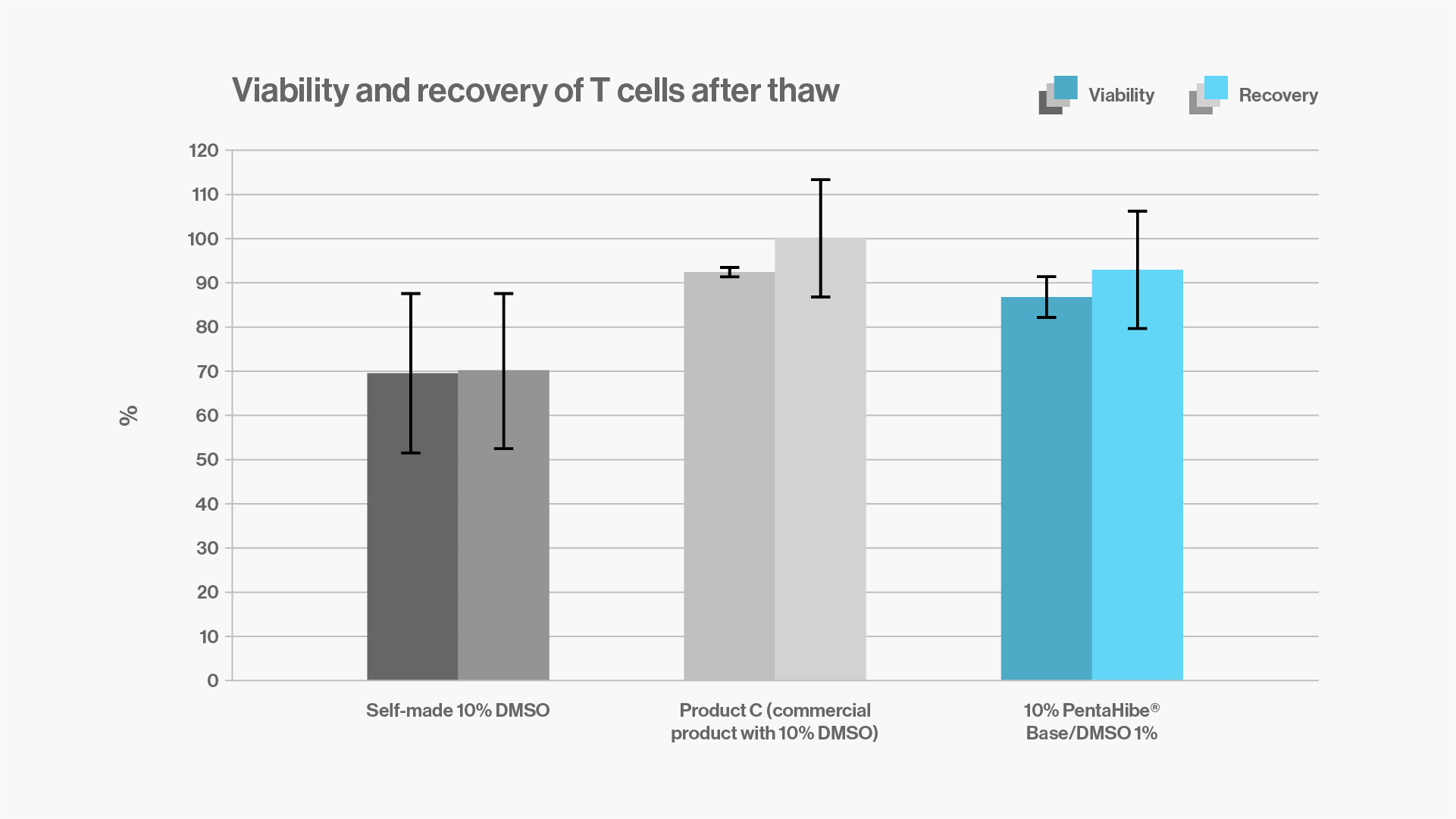
Objectives: to compare and evaluate the viability and recovery of T cells after cryopreservation with a self-made 10% DMSO formulation, a commercial product with 10% DMSO, or a custom-made formulation containing 10% Pentahibe® Base, 1% DMSO and 4% human albumin.
Results: T cells cryopreserved with a custom-made formulation with 10% Pentahibe® Base and only 1% DMSO show similar viability and recovery to self-made and commercial formulations with 10% DMSO.
Build defined cryopreservation formulations with PentaHibe Base and recombinant components — for fully animal-origin-free workflows.

Objectives: to evaluate the recovery and proliferation of T cells cryopreserved in a low-DMSO, fully animal-origin-free formulation (10% PentaHibe Base + 4% recombinant HSA [Optibumin® 25] + 2% DMSO), and to compare its performance with commercial animal-origin-free products containing 10%, 5%, or 2% DMSO.
Results: T cells cryopreserved with PentaHibe Base + Optibumin 25 showed comparable or superior post-thaw viability and expansion across donors relative to commercial products with 10% and 5% DMSO, while significantly outperforming the product with 2% DMSO, despite containing the same reduced DMSO level (2%). The formulation maintained strong T cell proliferation at 72h, supporting its use as a fully defined, animal-origin-free cryopreservation strategy.
- Pharmacosmos A/S
- Roervangsvej 30
- DK-4300 Holbaek
- Denmark
- Tel: +45 5948 5959
- Email: pentahibe@pharmacosmos.com
- Business hours are Monday to Friday 08:00-16:00 CET